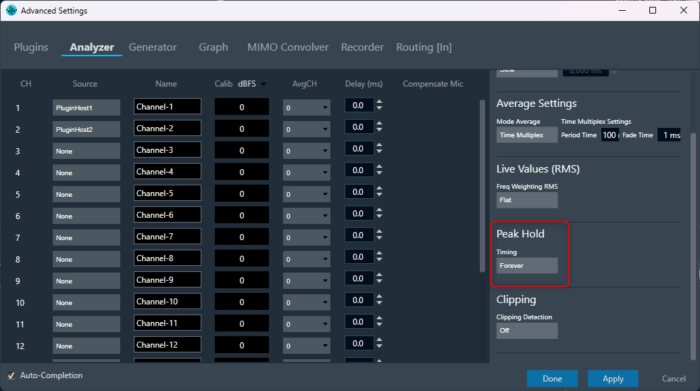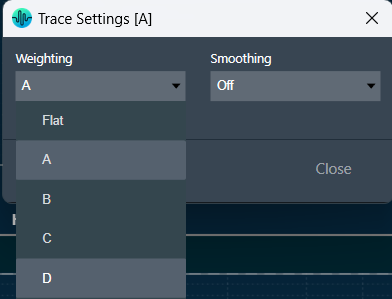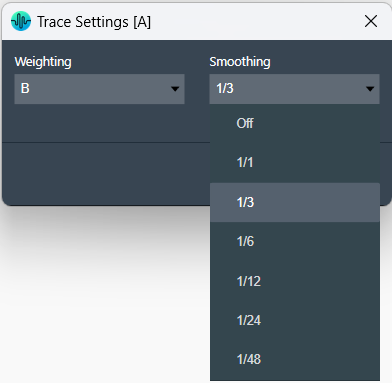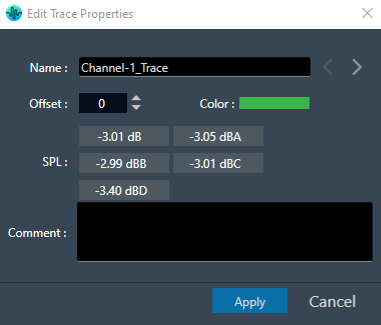The following are the operations you perform under the Trace configuration.
- Enabling Peak Hold Trace
- Setting Time Constants
- Weighting on Captured Traces
- Smoothing on Capture Traces
- Edit Trace Properties
The Peak Hold Trace can be activated using a checkbox in the ribbon bar – live values section. It’s time constants, Forever and Custom, can be selected in the normal Analyzer Settings in Advanced Settings window.
To activate the Peak Hold Trace, use the below option in ribbon bar,

After enabling the peak hold trace, if you switch to different channel, peak hold will be disabled on previous channel & enabled on new selected channel.
You can configure desired time constants for the Peak Hold Trace, such as “Forever” and “Custom” in the Analyzer Settings in Advanced Settings window.

The A-weighting, B-weighting, C-weighting, and D-weighting are different frequency weightings that simulate how sensitive various frequencies are to the human ear.
- A-weighting (dB(A)): A-weighting is used to approximate the sensitivity of the human ear to different frequencies at low sound pressure levels. It reduces the contribution of low and high frequencies to better represent the way humans perceive sound in relatively quiet environments. A-weighted measurements are often used in assessing environmental noise levels and evaluating noise exposure limits for occupational health and safety.
- B-weighting (dB(B)): B-weighting is rarely used and has limited practical application. It was initially intended to approximate the ear’s sensitivity at moderate sound pressure levels, but it didn’t gain widespread acceptance due to certain limitations. A-weighting has largely taken the place of B-weighting in modern applications..
- C-weighting (dB(C)): C-weighting is used to measure the overall sound pressure level without any frequency weighting. It includes the entire audible frequency range and does not attenuate any specific frequencies. C-weighted measurements are commonly employed in situations where a flat frequency response is desired or when assessing high-level noise sources, such as loudspeakers or industrial machinery.
- D-weighting(dB(D)): D-weighting is used to measure sound pressure levels with a frequency weighting that is specifically designed to reflect the human ear’s sensitivity to loud noises, particularly in the presence of high-level aircraft noise. Unlike C-weighting, D-weighting emphasizes certain frequency ranges to better correlate with the subjective perception of aircraft noise.
The weighting feature is used to adjust measurements to better align with the perceived loudness by human listeners.

When you select the “Trace Settings” option in the Traces toolbar, a new window will open, allowing you to choose the desired Weighting (Flat/Unweighted, A, B, C, and D).

Based on the desired selection, weighting will be applied to all captured traces. Each trace RMS SPL value will be displayed in the traces view as shown below.

Smoothing is a technique that reduces variations in plotted curves to improve the visual perception of trends or patterns in frequency response or level measurements. It is commonly used in audio analysis and equalization tasks to enhance clarity while considering the trade-off between noise reduction and preservation of important details.
When you select the “Trace Settings” option in the Traces toolbar, a new window will open, where you can select the desired octave banding for smoothing. Based on the desired selection, smoothing will be applied to all captured traces.

The smoothed curve with the chosen option looks like the figure below.

You can modify all the captured traces. Double-click on the trace to open the Trace properties window.

On the Trace properties window, you can modify the following property.
- Name of the trace – Modify the name of the trace.
- Offset value – Change the offset value.
- Color – Change the color of the trace.
- Comment – The provided comment will be exported and imported along with the trace.

